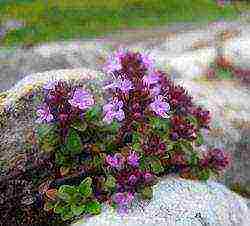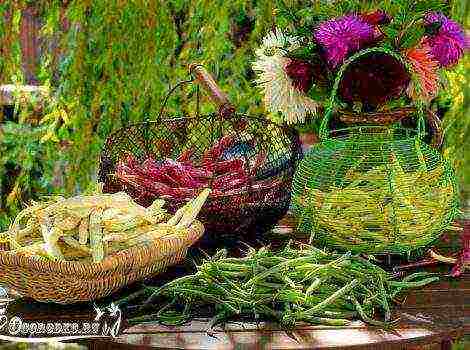Content [show]
The coniferous nursery would not look so impressive if it were not for the mountain pine. The natural form of Pinus mugo Mugus is charming, but has one drawback - unpredictability. Sometimes grown from seed, pine trees get a hybrid form and differ from their botanical characteristics. In this case, there is a need for frequent transplanting of the plant and making adjustments to the uniform growth of the tree, by means of clothespins. It turns out that such plants need care and attention, but what if the owners do not have time for this, but want to create a coniferous plant nursery in their yard?
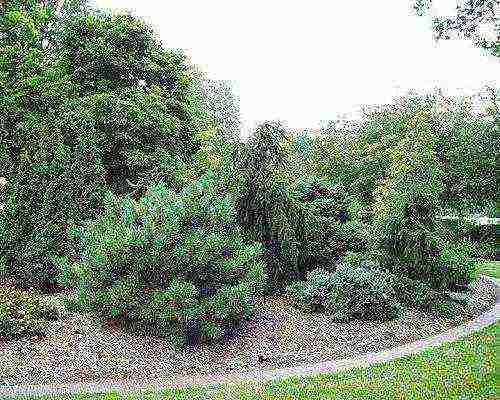
You can get out of the situation by choosing another member of the family, no less beautiful, but not so picky in care - Pinus mugo Mops. Trees of this species, propagated by grafting, are completely devoid of disadvantages. This is the best variety of true dwarf conifers that form an abundant globular crown.
The botanical characteristics of the species, which we will look at later, make the Pug pine variety so popular.
Growth features
Its annual growth rates are 8-10 cm in height and 13-15 cm in volume. This can be noted as slow growth. Growth is characterized by uniformity: the pug pine first acquires a spherical shape, and in adulthood, the correct cushion crown.
Thanks to such features as slow plant growth and stable formation of the pine crown, many gardeners and landscape designers around the world love it. This plant is used as an addition to the bonsai garden, which certainly fits in aesthetically. The tree variety was discovered at the beginning of the 19th century in Holland.
Description of the life form of the bush
Pug pine (mountain) - a dwarf shrub, dense compact spherical form. The bushes are distinguished by their durability: long-lived specimens grow up to 5 centuries. Adult plants reach an average height of 1.5-1.7 m, less often - 2 m.
The needles are distinguished by their shine, rigidity, collected in bunches of 2 pieces. The needles stay on the branches for 3-5 years, after which the pine crumbles and new needles grow. The color of the bristles is dark green. Cones with a wide conical section, ovoid, up to 6 cm in size. The color of the fruit is brown.

Pug pine is an ornamental plant used both for single plantings and as part of landscape groups. Representatives of this variety are characterized by:
- photophilousness;
- hygrophilousness;
- reduced requirements for soil;
- frost resistance.
Where and how to raise a "pug"?
These bushes grow well and form in open areas. Pines, representatives of this genus, root well due to the developed root system, therefore they are distinguished by wind resistance.
Although conifers are undemanding to the obesity of the soil, they grow best on sandy or sandy loam soils.If sandy rocks prevail in the soil, experts advise adding clay by creating a special soil mixture:
- sod land - 2 parts;
- clay or sand - 1 part.
When planting a plant in a hole, you can add 250-350 grams of lime.
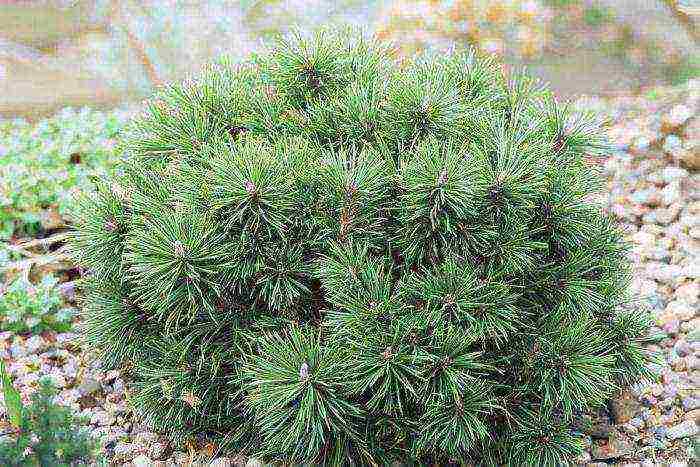
Pug pine care rules
Dwarf pine care includes the selection of fertilizers. For this, a nitroammophosphate compound is introduced (100 g will be enough). Systematically, during the first two years after planting, the plant is fed with a complex of mineral fertilizers, in the amount of 30-40 grams.
Mountain pine "mini-pug" is a drought-resistant plant that does not require additional watering. However, it is still necessary to add young plants: often and abundantly.
Loosening should be carried out as needed, when the soil is compacted or weed removal is required.
Mulching is carried out using a peat layer of 5-6 cm. As a result, the peat is not removed, but is mixed with the soil.
Pruning is carried out in order to slow down the growth of the plant and give the crown additional splendor. For this, parts of the annual growth of the branches are pruned.
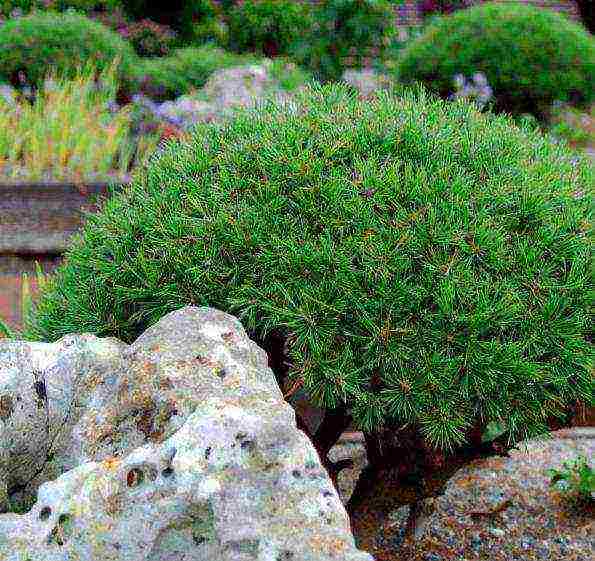
Of the pests, the bushes are affected by pine hermes. Conifers of this species are prone to blistering rust and resin crayfish (seryanka).
Getting ready for wintering
Pug pine is quite cold-resistant plant. The needles of young bushes, with the onset of the first spring sun, need protection, otherwise there is a risk of sunburn in the bush.
Mature pines do not require winter protection and easily tolerate frost.
A plant that can surprisingly complement any coniferous nursery is the "pug" pine, a description of which we have provided you in the article. We hope this information will be useful and will serve as a handy tool when growing this wonderful coniferous shrub.
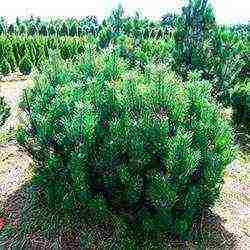 Conifers are very often used in decorating garden plots, as well as any other plots, since they are able to decorate them throughout the year, regardless of weather and other conditions. Mountain pine Mugus (aka shrub spherical pine) is one of the “favorites” among gardeners around the world due to its unpretentiousness and piquant appearance. Further, about the main varieties and features of growing mountain pine Mugus: planting, care in open ground (photo materials are attached).
Conifers are very often used in decorating garden plots, as well as any other plots, since they are able to decorate them throughout the year, regardless of weather and other conditions. Mountain pine Mugus (aka shrub spherical pine) is one of the “favorites” among gardeners around the world due to its unpretentiousness and piquant appearance. Further, about the main varieties and features of growing mountain pine Mugus: planting, care in open ground (photo materials are attached).
Mountain pine Mugus: description, characteristics of interesting varieties and varieties
Mountain pine Mugus is a shrub culture, although in natural conditions it most often looks like a tree. The shrub is tall - it can reach a height of 4-5 m, and the trees, on the contrary, are not very tall, the tops stretch to the sky at a height of 7-8 m.
The shoots of the shrub are rather short, spread along the ground, the direction of growth is upward. The root system is significantly ramified and is always located close to the soil surface. The color of the needles is presented in a dark green range, the length of the needles can reach 3-4 cm. The lifespan of the needles is about 6-8 years. After the shrub reaches this age, small cone-shaped cones appear on it, reaching a length of 4-5 cm.
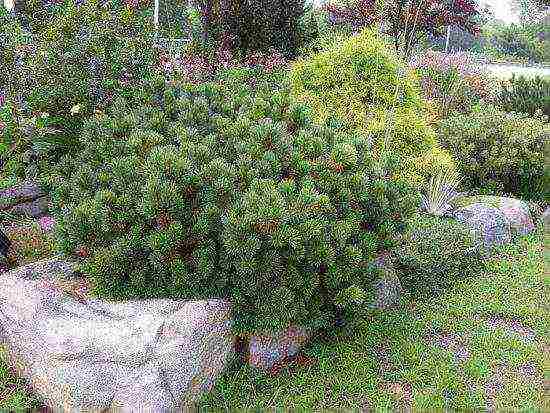
Mountain pine is a very hardy plant
The homeland of the Mugus pine is considered to be the Center and South of Europe, namely, their mountainous regions. Over time, the plant has spread widely as a horticultural crop throughout the world.
Pine Mugus is incredibly popular among gardeners due to its certain features:
- the plant is not afraid of frost;
- the pine is not afraid of the wind due to its powerful root system;
- the plant is not afraid of lack of moisture;
- the plant is not susceptible to disease;
- unpretentious to the soil on which the cultivation is carried out;
- tolerates pruning well;
- pine is considered a long-liver - the plant can live up to 1000 years.
The shrub variety of pine (mugus) is one of the most common, represented by a huge variety of varieties, among which the following can be highlighted (see photos of dwarf and soil varieties below):
- Pug. Representatives of the variety are considered dwarf shrubs. In height, they can reach no more than 1.5 m. The diameter of the crown and its height are most often identical. The shape of the crown is spherical. The dense needles are dark green in color. The plant is most often grown primarily as a tapeworm, but can sometimes be used in group compositions to create a rocky garden.

Pug variety
- Mini Pug. A smaller version of the previous grade. In height, the shrub rarely exceeds 0.5-0.6 m. But the crown is incredibly lush and large in size - it reaches about 1 m in diameter. Suitable for growing both in single and group plantings. Loves a little shading.
- Winter Gold. A dwarf variety with a spherical crown. The needles can change their shade depending on the season: in summer they have a soft green color, and in autumn they are golden. It rarely exceeds 0.5 m in height.

Variety Winter Gold
- Columnaris. The variety can reach a height of 2.5 m. The crown has a narrow conical shape. The needles are dark in color. Suitable for growing with tapeworm and as a group ornamental plant.
- Dwarf. The shrub reaches 2 m in height. The crown is spherical. Suitable for growing not only on lawns, but also on roofs, in containers.
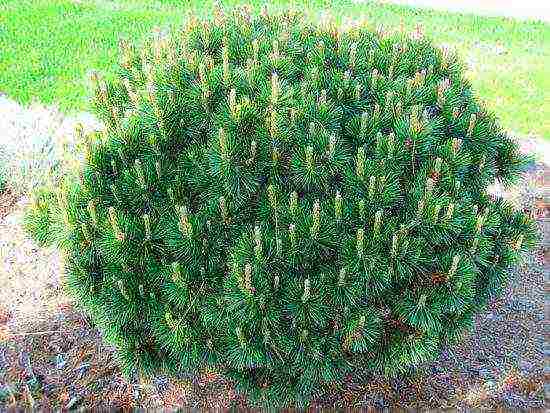
Gnome variety
- Ophir. An unusual dwarf variety, characterized by miniature growth: it rarely reaches half a meter in height. The crown is very similar in shape to the pin.
Planting a plant: basic rules
For the active growth of the pine and its long life in the garden, the site for planting in the open field should be chosen very carefully. For the successful cultivation of the Mugus pine, it is important to have a lot of sunlight. Therefore, the site must be well lit and warmed by the sun.
Pine is not very demanding on soil: it will grow well both on fertile soil and on soil devoid of nutrients. The acidity is not particularly important for the plant. However, if there is too much sand in the soil, it is better to add some clay to the soil to make it stronger.
Advice. The best option for planting pine is sandstone with a slightly acidic environment. It is in such a soil that the pine can achieve an incredibly beautiful decorative effect and the maximum possible development of the root system.
The best time for planting is spring (throughout the entire period). But in the fall, it is better not to plant a pine tree on the site, since it will have too little time in order to sufficiently strengthen its root system.
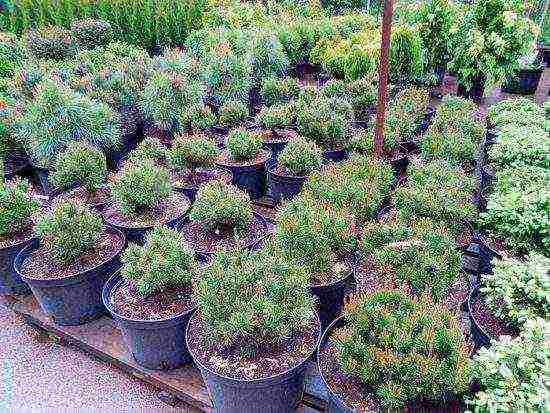
Mugus pine seedlings
Immediately before planting, a pit should be prepared: its depth should be about 1 m, and its width should be several centimeters larger than the earthen coma of the plant. At the bottom of the pit, a drainage layer (about 20 cm) of expanded clay, gravel, etc. is laid out. On top of the pit, the pit is filled with a prepared soil substrate, consisting of 2/3 of sod land and 1/3 of sand.
Now carefully place the seedling in the hole and fill it with the rest of the soil mixture, which must be lightly tamped, and then watered abundantly. The trunk circle must be mulched immediately after planting. If there are several pines, be sure to keep a certain distance between them - at least 1.5 m.
Reproduction of culture
Reproduction of the Mugus pine is theoretically possible in 3 ways: by seeds, cuttings and grafting. In practice, only the first two are realizable.
The seed method is optimal: in this case, you can grow a full-fledged, healthy and very beautiful shrub. It is advisable to stratify the seeds within a month before planting. While this process is taking place, prepare containers with nutritious light soil (they must have drainage holes).It is advisable to sprinkle the top with a small layer of peat, then disinfect it in the oven at low temperature.
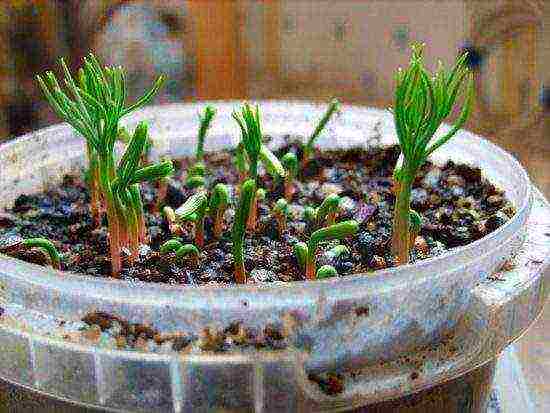
Pine sprouts
The seeds must be held in a disinfecting solution before sowing, then sown in containers with soil at a distance of about 5 cm from each other. Cover containers with foil. Shoots should appear within 20-30 days. In the open ground, the grown seedlings are planted in a couple of years.
Reproduction by grafting is a process so complex and rarely applied in practice that a separate article would be required to describe it. We can only say that if you succeed, then the young plant will be as beautiful and healthy as the mother.
Mugus pine care
Pine is an amazing plant that can actively grow and at the same time be completely healthy even with the most minimal care. Despite this, some of the intricacies of pine care, you should still know: this will help you achieve the maximum decorative effect.
Watering and feeding mode
Watering is not what the pine needs for full development. Almost all of its varieties live well without moisture. In addition, periodically falling needles act as a moisture-retaining layer. Unless young plants planted in spring will need additional moisture in the fall (after leaf fall). Watering will be necessary in order to protect the needles in the spring after the shrub wakes up, since moist soil will not freeze as much as dry soil.

You only need to feed a young pine tree.
As for dressings, they are necessary for the pine only in the first two years of its life. It is better to give preference to mineral fertilizing with a predominance of nitrogen. In the future, the pine will not need any additional nutrition: the organic matter that it receives from the coniferous litter under the tree is enough for it.
Plant pruning, pest control
The crown of pine trees is inherently attractive and therefore does not require pruning per se. If desired, you can add more aesthetics to the plant by slightly cutting off its shoots by about 1/3. In this case, the crown will become more lush, and the shoots will slow down growth. In the spring, all dried and frozen twigs must be removed.
Pine, like any other coniferous tree, rarely gets sick, but planting material may well be sick. The cause of the disease is most often the person himself, or rather, the measures he takes to care for the plant, climatic features, birds, etc.
Sometimes, after a too rainy summer or a harsh winter, a weakened plant can be attacked by shute (fungus). The needles change color to brown, and the branches dry out strongly. In some cases, coniferous needles fall off. To prevent the spread of infection, the plant should be immediately treated with a preparation containing copper, and the damaged parts of the shrub should be removed and destroyed.

Pine in landscape design
Sclerroleriosis is another disease that destroys apical branches. This happens most often due to improper trimming or its absence. The affected branches are immediately removed and sanitary pruning is carried out immediately.
Combination with other plants
Pine Mugus is actively used both as the main and as an auxiliary decorative element in landscape design. With the help of mountain pine, slopes are often strengthened and greened. Also, shrubs are quite often used in combination with birches, larch and other conifers for landscaping areas, creating hedges and strengthening the soil.
The different varieties of Mugus pine are excellent for container planting. It can be used in combination with small bush flowers to create rocky gardens.
That's all, in fact, what you need to know in order to successfully grow a worthy representative of conifers on a garden plot. Good luck!
Growing mountain pine: video
Mountain pine Pumilio is a low overgrown shrub. This plant looks very beautiful in landscape design: in single gardens, groups, rock gardens. In this article, we will analyze what a mountain pine is. Description, reproduction, care, planting of this shrub will be covered in this publication.
Description of the plant
Pumilio Pine is a compact dwarf evergreen shrub with a dense crown. The needles are short, needle-like, sharp, 3-4 centimeters in length. The shrub height ranges from 1.2 to 1.5 meters. Cones are cone-shaped, brown, shoots are directed upwards and form a dome.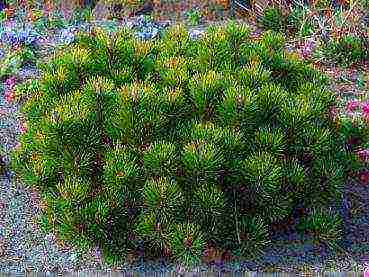
Planting and caring for a mountain pine in the garden is not difficult, since the plant is quite unpretentious to care for. Pine is sun-loving, but at the same time frost-resistant, tolerates periods of drought well, can grow on both acidic and alkaline soils.
The natural habitat is the central and eastern mountainous part of Europe.
After 30 years, the plant reaches 1 meter in height, and the annual growth is 5 centimeters in length and 12 centimeters in height.
Mountain pine Mugo Pumilio: planting and care
The plant does not tolerate darkened places, so it chooses a bright, well-lit area for planting. Pine can be planted in almost any soil, it grows even on nutrient-poor soil or dunes. In addition, the shrub is not afraid of the city's polluted air.
Before planting, it is recommended to calcify acidic soils a little; you can add slaked lime to the planting pit. In early spring, when the soil is still frozen, the pine should be sprayed and watered with warm water to wake it up after wintering. The rest of the time, care involves only moderate watering as needed.
Fertilizers are applied during the first few years after planting. Use a special mixture of fertilizers for conifers.
In some cases, an adult plant should be tied for the winter, since the branches may break under the weight of the snow cover.
Mountain pine propagates by seeds, cuttings or by grafting. The least popular is propagation by seeds, since in this case it is very difficult to maintain the varietal qualities of the mother plant.
Growing features
So, if mountain pine Pumilio has appeared on your site, planting and caring for it is not difficult. However, for the effective cultivation of a shrub, you need to know a number of features. First, the pine is watered only three times per season with a volume of 15-20 liters. Secondly, for the winter, young trees are protected with sawdust or spruce paws to avoid burns. Mineral fertilizers are used for the first two seasons.
On too heavy soils, pine needs at least a little drainage.
What else is the mountain pine Pumilio demanding for? Planting and caring for her should also include mandatory shelter from winter and spring sun rays. The shrub is protected from the sun for the first 2-3 years; it can be covered with burlap or spruce branches.
It is best to buy Pumilio pine seedlings in specialized nurseries, since the plants from them are adapted to local climatic conditions and take root well in a particular area.
If the autumn is long and rainy, then it is recommended to carry out preventive treatment of the shrub against fungal diseases.
Usage
The mountain pine Pumilio is very diverse in use. Planting and caring for it is not difficult, so it can be used as an undergrowth and ground cover plant, as well as for creating mixed groups. A shrub has proven itself in rocky gardens, on the banks of reservoirs, for fixing dry slopes.In addition, they can knock out other tall shrubs.
There are varieties of Pumilio pine that are suitable for growing in a pot. Thus, you can easily decorate balconies, roofs or a small city courtyard.
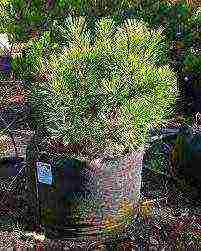
Since pine has phytoncidal properties, it is recommended to plant it near children's and health institutions.
Benefits of Pumilio pine
The undoubted advantages of mountain pine include its frost resistance, which makes it possible to grow shrubs in various regions. In addition, pine is undemanding to the quality of the soil, it can grow even in an urban climate and transfer air pollution and industrial emissions without losses. The extensive root system of the plant easily holds the fill soil. Pumilio pine is wind-resistant, tolerates shearing well and is an indispensable link in landscape design.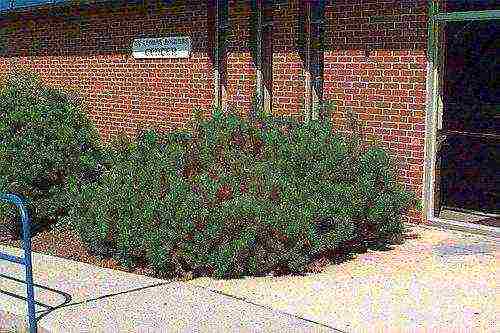
So, the article examined the mountain pine Pumilio. Planting and caring for the plant, the cultivation features are now known to you. Considering all the advantages of a shrub, we can conclude that the Pumilio pine is perfect for decorating a garden, and even a novice gardener can cope with caring for it.
A suburban area is a place of rest, relaxation. Therefore, everything should be perfect here, including the environment. It's about landscaping and green spaces. Proper planting and grooming is essential. The mountain pine Pumilio is an excellent option for summer cottages in any territory. This unpretentious, evergreen dwarf plant will diversify your environment, create an original style.
Thanks to the variety of shapes, colors and geometries of conifers, you can create individual attractive compositions with these plants. This dwarf pine goes well with a variety of deciduous and coniferous trees. Therefore, many summer residents are interested in proper planting and caring for the mountain pine Pumilio.
Description of mountain pine
Dwarf conifers are in high demand today. They are often used in the creation of landscape design for adjoining suburban areas. The homeland of this plant is considered to be the central and southern European mountain slopes. Dwarf pine differs from other conifers in its high density of a bush with strong branching. At the same time, the size of the plant is quite compact.
For gardeners, planting and grooming information is very important. The mountain pine Pumilio deserves attention. This plant adorns the garden not only in summer but also in winter.
The dwarf ephedra has a dark green color. The needles are needle-like, short, 4 cm long. The plant's height reaches 1.5 meters. The crown of the pine is open, dense. The branching of a plant near the ground can reach a diameter of up to several meters. This type of coniferous tree is a slow-growing one. After all, the height of a 30-year-old tree reaches 1 meter in height and 2 m in diameter. The annual growth of the plant is 5 cm wide and 12 cm high. Therefore, this plant is actively used in landscape design for the purpose of landscaping and arranging hedges. They are ideal background plants for floral and leafy compositions.
The cones of this ephedra are conical in dark brown color. In diameter, they vary from 1 to 5 cm. Most often, fruits appear in a plant that has reached 6 years of age. The shoots of the Pumilio pine grow straight up, forming an attractive crown dome.
Features of the Pumilio pine
Planting and caring for the Pumilio mountain pine requires a basic knowledge of conifers. In this case, the ephedra will thank the owner with a gorgeous green crown.
So, the plant must necessarily be on the sunny side of your site, because it belongs to the sun-loving ones. Irregular watering will not harm the plant, as it can survive in arid regions. Pumilio belongs to frost-resistant plants that are not afraid of severe frosts.
Advantage mountain pine Pumilio - planting and care. It is lightweight, there are practically no requirements. It is better to plant a seedling on unconsolidated acidic or alkaline soils. If the soil is healthy, then the plant will quickly take root. If your garden plot has heavy soil, you can add peat or sand to it.
Mountain pine in landscape design
The mountain pine Pumilio is irreplaceable when decorating stone gardens, alpine hills. This plant fits perfectly into the classic landscape style.
In addition to suburban areas, dwarf pine takes root well in the central parks of large cities. Some types of conifers are used to decorate public and office buildings. Often they are planted in pots outside.
This coniferous plant is used to decorate hedges and borders, high multi-tiered compositions. They are often planted near hedges of various origins. Dwarf conifers are often used to decorate a barbecue area or terrace. Widespread use requires knowledge of planting and grooming. The mountain pine of Mugo Pumilio will not only visually change the surrounding area, but also close the recreation area from prying eyes.
Dwarf pine goes well with almost anything. This tree, unlike other conifers, does not affect neighboring plants. An excellent combination for this bonsai is a variety of shrubs with large flowers and cereals. It looks attractive against the backdrop of huge boulders and alpine hills.
Many designers use an interesting combination of pine with low-rise maple saplings and heather orchards. In this case, it is necessary to competently organize the soil for the plants, because they require different soil acidity. Therefore, you should know the characteristics of each plant, its planting and care. The mountain pine Pumilio, with the right combination, will always delight the eye not only of the owners of a country house, but also of visitors.
Do you live in regions with heavy rainfall during the winter? Then immediately purchase such conifers. They will be the best winter garden decorations. Due to its good elasticity and strength, the branches of a dwarf pine tree will not break under the weight of a large layer of snow.
Many designers love the mountain pine Mugo Pumilio. Planting it can be carried out not only in open ground, but also in pots. Such decoration allows you to decorate loggias, roofs, entrances to buildings in an original way.
Mountain pine is also an indispensable plant in steep terrain. Thanks to the branched root system, the plant keeps well on steep mountain slopes, bulk soil or the banks of water bodies. This pine tree prevents landslides.
Planting and caring for the Pumilio Mountain Pine is simple. The main thing is to follow the basic rules described below.
Planting the Pumilio pine
Do you want to plant the mountain pine Pumilio on your site? Growing features are what you should pay attention to. Therefore, this plant should not be planted in dark places. For planting, it is better to choose a bright, sunny area. The quality of the soil for this plant practically does not play any role. Pine grows actively even on nutrient-poor soil. Dwarf pine takes root well in urban gas pollution.
Do you want the pine to quickly take root in a new place? Then pay attention to the conditions of the previous cultivation. The main task of every gardener is to repeat them as much as possible.
Conifers should be replanted in mid-spring or early fall. In winter, only large, adult plants with a well-developed root system are transplanted. The ideal age for transplanting a young seedling is 3-5 years.
A large pit should be prepared for planting. It should be twice the size of the plant's root system. Drainage should be laid at the bottom: gravel or broken brick, on top of which coarse sand is poured.If you wish to equip a hedge, the drainage layer must be laid along the entire length of the previously prepared trench.
If conifers are planted in a row, then a distance of several meters should be left between the seedlings.
When transplanting the Pumilio pine, you should monitor the stem collar of the seedling. It should be flush with the ground. It must not be deepened or raised.
Before planting a tree, it is advisable to calcify the acidic soil. For this, slaked lime is added to the planting pit.
The transplanted plants should be thoroughly watered and the soil around them should be compacted.
Plant care
In early spring, when the soil is still frozen, the pine should be watered and sprayed with warm water. So the plant will quickly wake up after sleep and again begin to actively grow branches. After leaving, it consists in periodic moderate watering of the soil as needed. The mountain pine Pumilio used in landscape design is recommended by experts to be watered 3 times per season. Pour about 2 buckets of water under one tree.
It is necessary to apply fertilizers to the soil in the first few years after planting. To do this, use a special mixture of fertilizers designed specifically for conifers.
In the fall, you should prepare a young pine tree. It is protected with spruce paws or sawdust to prevent burns. Some gardeners cover the plant for the winter with non-woven fabric or spruce branches. This cover is removed in April, when all the snow has completely melted.
At the end of winter, the tree is pruned, removing dried branches.
Reproduction of pine
Reproduction of a plant occurs in three ways: by grafting, by seeds and by cuttings. Less commonly, the plant is propagated by seeds. This method does not guarantee the preservation of the varietal qualities of the mother plant. Seeds are planted in spring in prepared, fertilized and loosened soil in pots.
Cuttings are also harvested in spring. For this, healthy mature trees are used. If you want to propagate pine in the winter, then the cuttings can be prepared at negative temperatures. But in this case, they must be stored at home.
For watering the workpieces, you should use water with a growth stimulant dissolved in it. In this case, the water should be at room temperature.
Pine diseases
As you already know, with this plant everything is simple: use, and planting, and care. Mountain pine is extremely popular, because for a long time it pleases the eye, while requiring a minimum of maintenance. In addition, the Pumilio pine is resistant to various diseases, which cannot be said about other conifers.
The only problem is fungal disease. Schütte disease is characterized by blackening of the branches and rapid drying of the needles. Coping with this scourge is easy - you should treat the plant with a fungicide.
But if this disease appears in a plant in the first 3 years of its life, most likely the seedling will die. Therefore, seedlings should be purchased from proven horticultural associations.
Conclusion
The dwarf Pumilio pine is an excellent ornamental plant that is actively used in landscape design. They love it for its beauty and grace, minimal care and bright color. Having bothered to create a unique project with dwarf pines, you can get a unique beautiful result that you can admire for many years.
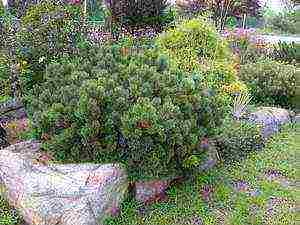 Pumilio mountain pine is one of the most common varieties of this plant, which is used by humans for decorative purposes. It is a small dwarf shrub that has a crown spread over the ground, as it were.
Pumilio mountain pine is one of the most common varieties of this plant, which is used by humans for decorative purposes. It is a small dwarf shrub that has a crown spread over the ground, as it were.
Description of the Pumilio pine
An evergreen shrub. Has a very dense crown. The needles are bright green in color with very hard short needles (approximately 3.5-4 cm). in height, the mountain pine Pumilio grows no more than one and a half meters, but in breadth it grows up to 3 meters in diameter. Cones in the shape of a cone, about 4 centimeters. Shoots spread along the ground, and branches grow very densely upwards from them.
Often this type of mountain pine is used in landscape design, since the plant is very unpretentious for growing.
Pumilio is very fond of the sun, but at the same time tolerates frost perfectly. Drought is also not terrible for the plant. Soil for planting pine any can be used, even alkaline or acidic. The main condition is that there is a bright sun, the shrub will not take root in the shade. It grows very slowly.
In the wild, Pumilio is found in the mountainous regions of Central and Eastern Europe.
How to grow Pumilio on a garden plot?
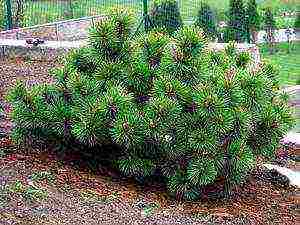 The most important thing when planting a plant is to find a well-lit area. Do not pay attention to the soil. Bush can even grow in dunes... Environmental conditions, even the worst ones, do not have a detrimental effect on the shrub. A small amount of nutrients in the soil, the air polluted by cars and factories will in no way interfere with the growth of Pumilio.
The most important thing when planting a plant is to find a well-lit area. Do not pay attention to the soil. Bush can even grow in dunes... Environmental conditions, even the worst ones, do not have a detrimental effect on the shrub. A small amount of nutrients in the soil, the air polluted by cars and factories will in no way interfere with the growth of Pumilio.
When planting a plant, dig a hole of the required volume. If the soil is very acidic, add slaked lime to the hole.
Features of caring for Pumilio
- In order for the plant to take root well and delight you for many years, you should take good care of it and study some of the features in the cultivation of this shrub.
- In early spring, to awaken the bush, it must be sprayed. Watering at this time should be done with warm water. Then water the mountain pine as the soil dries out, avoiding excessive moisture.
- To fertilize the soil, use any coniferous plant mix available at your local hardware store.
- In case of heavy snowfalls in your area, for the winter the shoots of the mountain pine should be tightly tied to prevent the branches from breaking.
- It is best to propagate an adult plant by cuttings or by grafting. Reproduction by seeds is possible, but such an shoot rarely takes root, and the varietal qualities of the mother plant may be lost.
- According to the rules, mountain pine Pumilio is watered 3 times per season, using about 20 liters of water.
- For the winter, it is best to cover the young plant with sawdust so that the plant does not die during severe frosts.
- Although the plant is very sun-loving, but for the first 2-3 years it should be protected from direct sunlight. Therefore, in the daytime it is recommended to cover the plant with a matting or spruce branches.
- With frequent rains and constant dampness, especially in the autumn. Experts advise treating the shrub with antifungal agents.
Advantages of Pumilio from other varieties of mountain pine
Most of the positive qualities of this type of mountain pine have already been discussed above, but they should be systematized.
-
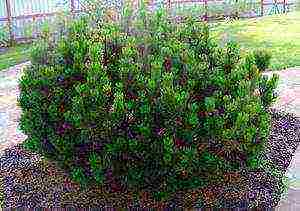 Frost resistance.
Frost resistance. - Growing in any soil.
- The ability to grow in any even gassed air.
- Wind resistance.
- Easily transfers a haircut, so you can create fancy shapes from the crown.
- Any beginner in landscape design can grow it.
Where to use the Pumilio pine?
From this ornamental shrub you can create absolutely any shapes in the interior of your garden. It is used both for covering the ground and for creating undergrowth. You can plant a pine tree on the banks of an artificial reservoir and in a rocky garden. A small plant can also be grown on the balcony in a beautiful pot, so Pumilio will decorate even your home decor.
In some cases, the Pumilio pine is grown on the roofs of houses, where it beautifully decorates the surface with its crown.
Popular types of mountain pine and their features
Mountain pine has a huge number of types, each of which is of interest. Let's consider the most popular ones.
-
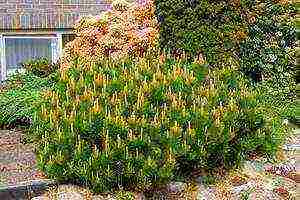 Brevifolia. The crown is barrel-shaped.
Brevifolia. The crown is barrel-shaped. - Winter Gold. Changes the color of its needles. It is golden in winter and bright green in summer.
- Dwarf. The crown reaches a height of no more than 2 meters and a diameter of about 2 meters.
- Pug. Globular shrub.Propagated by vaccination. It reaches a height of about 1.5 meters.
- Mogus. This species is often confused with the Pumilio pine, as they are very similar in appearance. Propagated by cuttings and seeds.
Unpretentious evergreen bush Pumilio it is liked by both novice gardeners and professionals. Try to grow this mountain pine on your site and its beauty will adorn your individually created landscape.
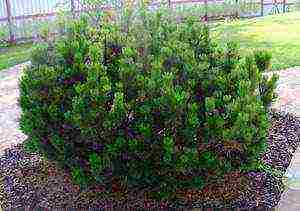 The mountain pine Pumilio is one of the most popular varieties used by humans for decorative purposes. It is a dwarf shrub that spreads its weaving crown on the ground.
The mountain pine Pumilio is one of the most popular varieties used by humans for decorative purposes. It is a dwarf shrub that spreads its weaving crown on the ground.
In nature, it grows in the central and eastern mountainous part of Europe. At 30 years old, the plant reaches 1 meter in height, and the annual increase is 5 cm in width and 12 cm in height.
Description
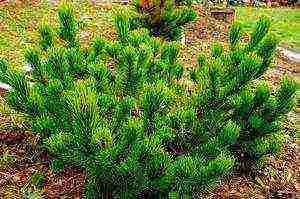 Pine Mugo Pumilio is a small-sized low evergreen bush with a branched crown. It has foliage in the form of short pointed needles 3-4 centimeters long. Height varies from 120 centimeters to 150 centimeters. Fruits in the form of cone-shaped cones, coffee-colored, the processes are directed strictly upward and create a dome.
Pine Mugo Pumilio is a small-sized low evergreen bush with a branched crown. It has foliage in the form of short pointed needles 3-4 centimeters long. Height varies from 120 centimeters to 150 centimeters. Fruits in the form of cone-shaped cones, coffee-colored, the processes are directed strictly upward and create a dome.
Planting and leaving is easy because the plant is unassuming to care for... Sun-loving, frost-resistant, withstands drought well, grows both on acidic and alkaline soils.
Pine species
Mountain pine has a large number of varieties. Let's analyze the most popular ones.
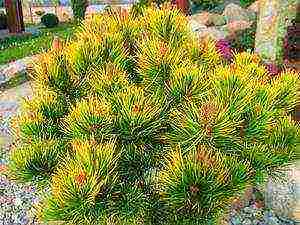 Brevifolia... This variety has a barrel-shaped crown shape, the bush is 48 cm high.
Brevifolia... This variety has a barrel-shaped crown shape, the bush is 48 cm high.- Winter Gold... It is a dwarf slow-growing shrub with a compact spherical bush, needles in winter are golden in color, in summer they are light green in color. The pine tree reaches a height of 48 cm and a width of 90 cm.
- Dwarf... It is a shrub, a couple of meters in height and a couple of meters in width, with a spherical bush. This species reproduces by vaccination.
 Kobold... The variety is a meter-long shrub with an extensive spherical crown.
Kobold... The variety is a meter-long shrub with an extensive spherical crown.- Columnaris... This variety is a shrub 2.5 meters high and 1 meter wide. Foliage with a rather interesting crown shape.
- Pug... A spherical slow-growing bush, 1.4 meters tall, propagated by grafting.
- Mugus... Creeping shrub, several meters high, 4 meters wide. The pine tree has a horizontal type of arrangement of processes, their tops are raised upward. This variety is propagated using grains and cuttings.
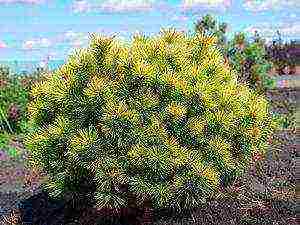 Ophir... A dwarf variety, with a flat, pin-like shape. Height 35 centimeters, width 55 centimeters. It has golden needles.
Ophir... A dwarf variety, with a flat, pin-like shape. Height 35 centimeters, width 55 centimeters. It has golden needles.- Pumilio... This variety is creeping, 3 meters tall. This variety is propagated using grains and cuttings.
- Frisia... It is a two-meter shrub. 150 centimeters wide. Propagated using grains, cuttings or grafts.
- Humpy... This variety is a dwarf spherical shrub, 90 centimeters high, with a crown diameter of 1.4 meters.
Planting and leaving
 The plant does not feel well in darkened areas; clear, well-lit areas are chosen for planting pines. Pine is planted in any land, it grows even on soil that is not rich in nutrients or dunes. The shrub is not afraid of the city's polluted atmosphere.
The plant does not feel well in darkened areas; clear, well-lit areas are chosen for planting pines. Pine is planted in any land, it grows even on soil that is not rich in nutrients or dunes. The shrub is not afraid of the city's polluted atmosphere.
Before planting, it is recommended to calcify acidic soil or pour freshly slaked lime into the planting recess. In early spring, when the ground is still frozen, the pine is sprinkled and watered with warm water to revive after wintering. The rest of the time, watered as needed. Fertilizers are applied in the first two seasons after planting. An adult plant is tied for the winter, as branches break under the load of snow cover.
-
 Choosing a place for planting, soil... Mountain pine selects clear, sunny areas. Various lands are suitable for planting: sandy, siliceous, moist and acidic clays.With high salinity and soil compaction, as well as when planting in the shade, resistance to pests and diseases begins to decrease. Pine is well adapted to urban environments. When landing on weighed damp lands, the soil for filling into the planting pit is facilitated by mixing in sand or peat.
Choosing a place for planting, soil... Mountain pine selects clear, sunny areas. Various lands are suitable for planting: sandy, siliceous, moist and acidic clays.With high salinity and soil compaction, as well as when planting in the shade, resistance to pests and diseases begins to decrease. Pine is well adapted to urban environments. When landing on weighed damp lands, the soil for filling into the planting pit is facilitated by mixing in sand or peat. -
Landing... Would you like to plant the mountain pine Pumilio on your own plot? This plant is not planted in shaded areas. A clear, sunny, cloudless area of the garden is chosen for planting. The characteristics of the soil for this shrub are unimportant. Pine grows briskly even on soil that is not rich in nutrients. A low-growing plant perfectly rooted in urban gas-polluted conditions.
Do you want the pine to take over in a new place? Then it is necessary to reproduce as much as possible the conditions of cultivation in the previous place. Conifers are transplanted in mid-spring or early autumn. In the winter season, only adult plants with a developed root system are moved. The perfect age for transplanting a young bush is from 3 to 5 years.

A large pit is being prepared for disembarkation. It should be twice the size of the pine roots. Drainage from gravel or broken brick is lowered to the bottom, coarse sand is poured on top. If a live fence is being made, then the drainage layer is placed along the entire length of a previously dug trench. If the pines are planted sequentially, then a distance of several meters is maintained between the seedlings.
When transplanting the Pumilio pine, the stem neck of the seedling is placed on the same level with the ground without deepening or raising it. Before planting, the acidic soil is calcified. For this, slaked lime is poured into the planting pit. The transplanted plant is thoroughly watered and the soil around it is compacted.
-
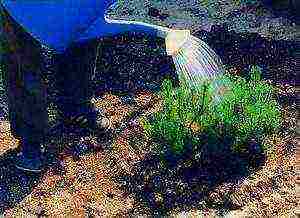 Care... In early spring, when the soil is still frozen, the pine is watered and sprayed with warm water. So the plant quickly revives after sleep and begins to grow vigorously. Then periodically water the soil moderately as needed. The mountain pine Pumilio is watered three times a year. Two buckets of liquid are poured out under one bush.
Care... In early spring, when the soil is still frozen, the pine is watered and sprayed with warm water. So the plant quickly revives after sleep and begins to grow vigorously. Then periodically water the soil moderately as needed. The mountain pine Pumilio is watered three times a year. Two buckets of liquid are poured out under one bush.
Fertilizers for conifers are introduced into the ground for the first couple of years after planting a pine. In the fall, prepare a young pine for wintering. It is protected with spruce paws or sawdust to prevent burns. They also hide the plant for the winter under a non-woven fabric. The shelter is removed in April, when all the snow has melted.
Reproduction
 Pine reproduces:
Pine reproduces:
- grains
- cuttings,
- vaccination.
Propagation by grains is the least popular and extremely laborious method, since it is difficult to preserve the original qualities and purity of genetic matter.
Propagation by cuttings is carried out in the spring. One-year-old shoots are collected from young bushes and cut off with a heel. Then they are placed in water for several hours, and then in a growth stimulating preparation. Following this, the cuttings are planted to a depth of 5 cm in a soil mixture containing equal proportions of sand, turf and peat. A pot with cuttings is placed in a greenhouse, and with warming is transferred to the street. It is not bad to make the cuttings lower heating, for this, during planting, a layer of manure crushed by the soil is built.
Growing features
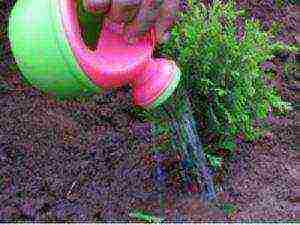 Planting and caring for a pine tree is not difficult. The bush is irrigated 3 times a year with 15-20 liters of water. For the winter, young trees are covered with sawdust or spruce paws. Mineral fertilizers are used for the first couple of seasons. On heavy soils, at least a little drainage will be needed.
Planting and caring for a pine tree is not difficult. The bush is irrigated 3 times a year with 15-20 liters of water. For the winter, young trees are covered with sawdust or spruce paws. Mineral fertilizers are used for the first couple of seasons. On heavy soils, at least a little drainage will be needed.
What else is the whimsical mountain pine Pumilio for? They shelter the plant from winter and spring sun rays. The shrub is protected from the sun for the first couple of years, covered with burlap or spruce branches. Seedlings are purchased in special nurseries, because the shrubs from them are adapted to the surrounding climatic conditions. In a protracted and rainy autumn, prophylactic treatment of shrubs against fungal diseases is carried out.
Pine diseases
 In the case of dank and damp autumn weather, there is a danger of fungal attack on the shrub. In such an opportunity, they are treated with fungicides. Also a serious danger is the scale insect, which damages the coniferous foliage and seems to sow the bush with sticky syrup. Bedbugs also attack, they lead to drying of the tops of the branches and dullness of coniferous needles. To the spots on the needles leads also to the illness of shute. All these diseases are treated by systematic sprinkling of preparations specially developed for coniferous plants, which are sold in special horticultural centers.
In the case of dank and damp autumn weather, there is a danger of fungal attack on the shrub. In such an opportunity, they are treated with fungicides. Also a serious danger is the scale insect, which damages the coniferous foliage and seems to sow the bush with sticky syrup. Bedbugs also attack, they lead to drying of the tops of the branches and dullness of coniferous needles. To the spots on the needles leads also to the illness of shute. All these diseases are treated by systematic sprinkling of preparations specially developed for coniferous plants, which are sold in special horticultural centers.
The use of pine
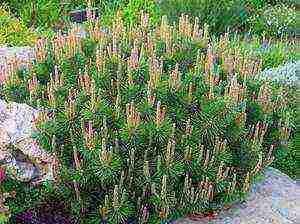 The application of the mountain pine Pumilio is very diverse. Planting and caring for the bush is not at all difficult, therefore it is used as part of the underbrush and ground covering plant, as well as for organizing heterogeneous groups. The shrub has proven itself well in siliceous gardens, on the coastal zones of water bodies, it is used to strengthen dried up slopes. In addition, they can make undergrowth of other tall trees. Numerous species are used in decorative gardening and landscaping.
The application of the mountain pine Pumilio is very diverse. Planting and caring for the bush is not at all difficult, therefore it is used as part of the underbrush and ground covering plant, as well as for organizing heterogeneous groups. The shrub has proven itself well in siliceous gardens, on the coastal zones of water bodies, it is used to strengthen dried up slopes. In addition, they can make undergrowth of other tall trees. Numerous species are used in decorative gardening and landscaping.
In Hungary and Switzerland, the popular Hungarian balsam is made from young twigs and cones - a unique bitter liqueur kept on herbs, the recipe of which was created back in 1790 and is carefully taken care of by the Zwak family to the present day. In addition, pine elements are finding their own uses in medicine and cosmetology.
Benefits of Pumilio pine
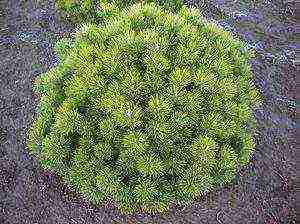 The indisputable advantages include its cold resistance, which allows you to grow shrubs in various regions. In addition, it is unpretentious to the quality of the soil, it can grow even in an urban climate and can easily withstand the gas pollution of the atmosphere and industrial emissions. The wide root system of the plant easily holds the bulk soil. It is wind-resistant, painlessly withstands a haircut and is an indispensable link in landscape design. Having considered all the advantages of a plant, we can summarize that it is perfect for decorating a garden, and even a novice gardener can take care of it.
The indisputable advantages include its cold resistance, which allows you to grow shrubs in various regions. In addition, it is unpretentious to the quality of the soil, it can grow even in an urban climate and can easily withstand the gas pollution of the atmosphere and industrial emissions. The wide root system of the plant easily holds the bulk soil. It is wind-resistant, painlessly withstands a haircut and is an indispensable link in landscape design. Having considered all the advantages of a plant, we can summarize that it is perfect for decorating a garden, and even a novice gardener can take care of it.
The dwarf pine Pumilio is an excellent ornamental plant, widely used in landscape design. They respect him for his good-naturedness and grace, easy care and spectacular coloring.
> > > > > >
Mountain pine Mugus belongs to shrub crops. In its natural environment, it most often looks like a tree. It can reach a height of up to 4 meters.
Description and care
The plant has short shoots that spread along the ground, growing upward.
The root system of the Mugus pine is branched, located close to the surface of the earth. The needles have a dark green color, the length of the needles is up to 4 cm.After 6 - 8 years of growth, decorative cone-shaped cones, up to 5 cm long, appear on the branches.
Plant features
Mugus is very popular among gardeners for several reasons:
- Good frost resistance.
- The pine tree is not afraid of strong winds.
- Tolerates dry periods.
- Mugus is not susceptible to disease.
- Unpretentious to the soil.
- Tolerates pruning well.
- Mugus is a long-liver. The life cycle of a plant is up to 1000 years.
Mugus pines are planted in open areas with sufficient sunlight. The plant is not demanding on the soil, however, if the soil contains a lot of pestle, it is worth adding a little clay to strengthen it.
It is best to plant seedlings in the spring. Gardeners do not recommend planting in the fall, because before the onset of frost, the plant may not have time to strengthen its root system in the soil.
Landing rules:
- The depth of the hole should be about 1 m, the width on all sides is several centimeters larger than the root system of the plant.
- The bottom is covered with a drainage layer by 20 cm. Use gravel, expanded clay, etc.
- A soil substrate is poured, consisting of 1/3 of sand and 2/3 of sod land.
- The seedling is placed in a hole and covered with the rest of the soil mixture on top.Well rammed, watered.
- The trunk circle is immediately mulched.
Important! When planting several pines, the distance between the seedlings should be at least 1.5 meters.
Basic rules of care:
- In the fall, after the leaves have fallen off, young seedlings need watering. Adult pine trees do not need additional moisture.
- Mineral dressing is added only in the first two years of life. Further, the plant has enough organic matter from the outside.
- Dried twigs are cut in the spring. To give splendor, young shoots are pruned by 1/3.
You can buy Mugus Pine saplings here. There are enough plants there. The staff will tell you in detail about the basic rules of planting and caring for the plant.
